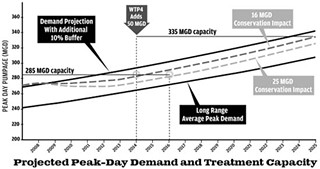City Hall Hustle: The Magic Water Bullet
AWU's water-demand projection needs its own Zapruder film
By Wells Dunbar, Fri., July 31, 2009

If the recent City Council presentation on the conspiracy-steeped Water Treatment Plant No. 4 was the municipal equivalent of the Warren Commission Report, then the solid lines on a graph projecting Austin's future water needs recall the Magic Bullet. Never since JFK has a line's trajectory been so studied and scrutinized.
Underscoring the similarly circuitous path of the plant, Assistant City Manager Rudy Garza began his WTP4 presentation by noting, "Actually, when I was 9 years old, this project first started discussion, in 1975." Very long story made abruptly short, the city's plans for its fourth water treatment plant – after Ulrich, Davis, and the now-shuttered Green – have changed more over the years than theories about the Grassy Knoll. The original plan, tapping Lake Travis from the headwaters of Bull Creek in northwest Austin, was abandoned. Another site in the Balcones Nature Preserve was shelved. Ultimately, the city bought a tract of land at FM 620 and Bullick Hollow to house the plant, paying some $32 million.
As the latest official skeptics of the Delayed Plant of Debatable Necessity (there's probably a Chinese character by now), new Council Members Chris Riley and Bill Spelman made inquisitive noises as soon as they were inaugurated – unsurprisingly, considering conservation was a tent pole of Riley's campaign and financial stability one of Spelman's. Last Thursday, their first meeting, they put the plant directly in the hot seat.
The Austin Water Utility says that in order to replace Green's closure and meet peak-day demands, the plant is needed by 2014. The water utility is eager to move forward; this briefing was precursor to an Aug. 6 vote approving a construction manager and other contracts. AWU Director Greg Meszaros spent the presentation enumerating the plant's environmental benefits (10,000 metric tons of carbon emissions saved in the first year, by rolling water down the steep grade from Lake Travis instead of pumping it), warning of delays ("It would be very easy ... to slip a year or two," he said, with no hint of irony), and pitching the savings to be achieved by building in an off economy (a cost estimate of $508 million, assuming 2014 completion, could be shaved by $23 million to $45 million with a 5% to 10% reduction in bids; WTP4 opponents, prominently the Save Our Springs Alliance, point to a December 2006 cost estimate listing the full cost at $849 million, including debt payments).
The real intrigue came with the graph, which set some sort of Channel 6 record for screen time. "I think some of the critical trend lines here are the blue lines, particularly the upper blue line," said Meszaros, referring to a demand projection (black in the version reproduced above) – sans any conservation measures – that includes a buffer of an additional 10%. The dotted line beneath lops off 16 million gallons per day, a partial implementation of the city's Water Conservation Task Force goal of reducing use by 25 MGD, the larger goal represented in the second dotted line. The 16 MGD line intersects with current capacity at 2014, the "sweet spot," according to Meszaros, when the utility wants to have WTP4's first 50 million gallons a day online. (The final, potential build out of the plant, subject to future demand, is for 300 MGD.)
Not plotted, however, is the point at which the lower blue line – a projection of long-range demand as-is, without any additional buffer or allowance for conservation improvements, and only for the peak days the utility pumps the most – meets current capacity. It intersects around 2020 – and Riley wanted to know whether that could be further delayed. "When we talked during the Water Conservation Task Force about first steps and pursuing other things in the future, was that really just talk?" he queried Meszaros. "You didn't expect we would ever do anything more without radically changing our lifestyles? We've done about all we can do?" After the director outlined further possible conservation measures, attorney Riley moved in for the close: "If we move forward on every one of those things you just mentioned, we still wouldn't see any change in the lines on the graph?" Meszaros conceded that achieving greater conservation would buy more time.
After Riley's cross-examination, Spelman questioned Meszaros professorially, noting that last summer's peak-day pumpage was 228 MGD, well below the chart's 240 MGD starting point. He also questioned the financial wisdom of moving quickly, noting that three years' worth of additional accrued interest on the cash the city would spend on the plant would outstrip any savings by acting now. That is, "if this were purely a financial decision, and, of course, it's not."
Now the question is whether Spelman and Riley can convince other council members to join them in possibly delaying the plant. Randi Shade and Laura Morrison both discussed the need for reserve capacity, exacerbated by Green's closure and the age of Davis, presumably staking out wiggle room between Riley and Spelman and WTP4 supporters Lee Leffingwell and Sheryl Cole.
But whatever happens next Thursday, certainly, the conspiracy will live on.
Connect with the Hustle on Facebook: www.facebook.com/cityhallhustle.
Got something to say on the subject? Send a letter to the editor.








